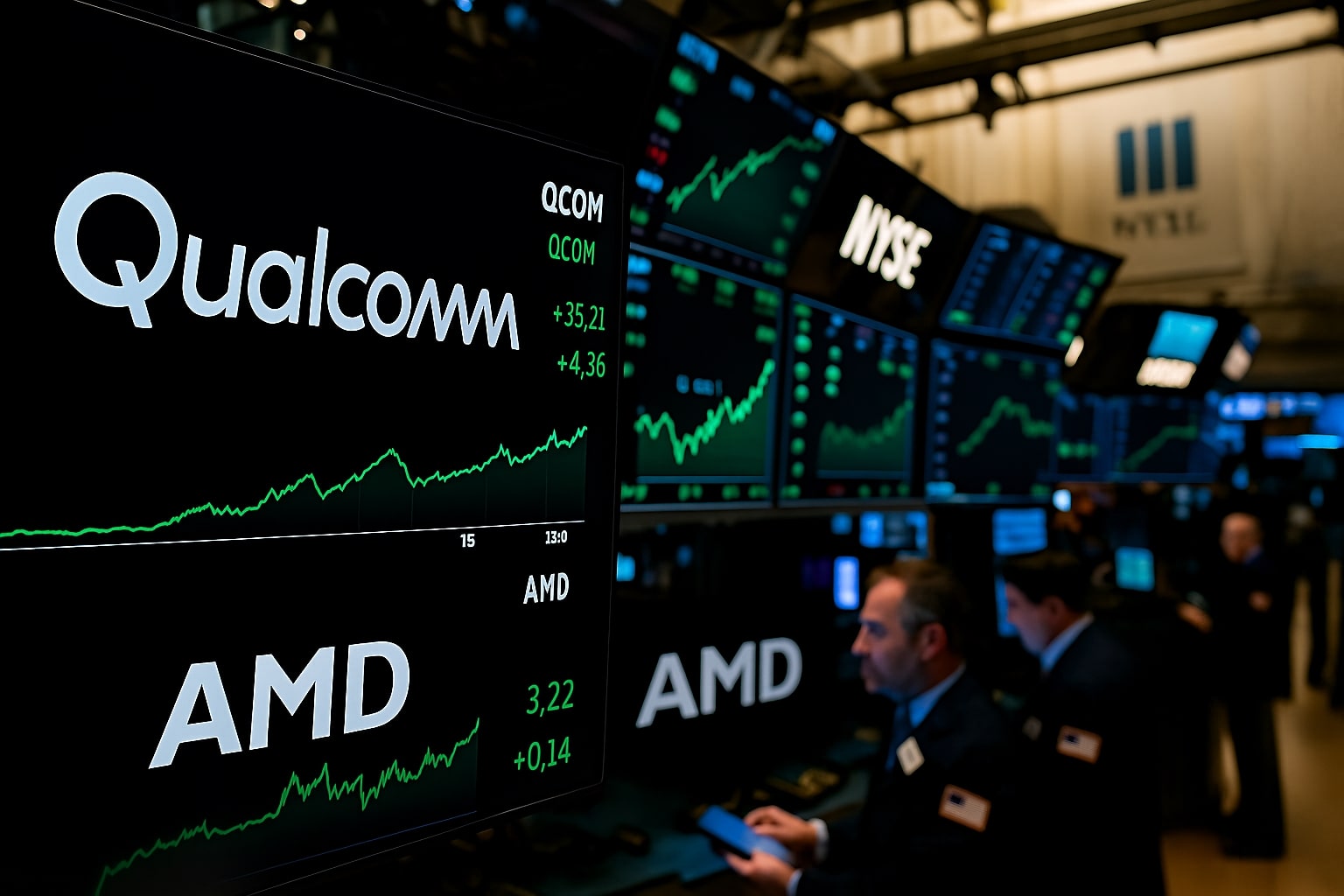
AMD Stock vs QCOM Stock Which Stock Wins at $160?
AMD’s AI-driven growth story faces margin pressure, while Qualcomm delivers steady earnings, dividends, and IoT expansion | That's TradingNEWS
AMD (NASDAQ:AMD) vs Qualcomm (NASDAQ:QCOM): A Detailed Stock Comparison
When weighing Advanced Micro Devices (NASDAQ:AMD) against Qualcomm (NASDAQ:QCOM), the two chipmakers present very different valuation profiles, growth trajectories, and investor sentiment trends. Both are trading in a similar price zone — AMD at around $160 per share and QCOM near $159 — yet their market caps, balance sheets, and growth narratives diverge sharply, making the comparison highly relevant for investors assessing where capital might earn a stronger return over the next 12–24 months.
Valuation and Market Capitalization
AMD commands a market capitalization of roughly $260 billion, significantly larger than Qualcomm’s $171 billion. That gap is reflected in their valuation multiples: AMD trades at a forward P/E near 41x, while QCOM sits at only 13x. On an EV/EBITDA basis, QCOM is priced at 11.9x, compared to AMD’s stretched multiple in the high 20s. Investors are clearly paying a heavy premium for AMD’s growth optionality in artificial intelligence and data centers, while Qualcomm is priced more conservatively, reflecting skepticism about handset dependency despite clear traction in auto and IoT.
Revenue and Growth Momentum
AMD’s second-quarter 2025 revenue came in at $7.7 billion, up 31.7% year-over-year, with client and gaming leading the surge at $3.6 billion, a 69% YoY increase. Data center revenue slowed, however, to $3.2 billion, just 14% growth, compared to 57% in the previous quarter. Adjusted EPS landed at $0.48, down 30% YoY, largely due to export restrictions, though management guided Q3 revenue toward $8.7 billion. Wall Street’s revenue estimates hover at $8.8 billion, with EPS near $1.15.
Qualcomm, by contrast, reported $10.37 billion in quarterly revenue, up 10.4% YoY, with EPS at $2.77, ahead of the $2.71 consensus. Guidance points to $10.7 billion revenue and EPS of $2.85 for the next quarter. Segment growth is robust: automotive up 21%, IoT up 24%, and handsets climbing 7%. Net margins are 26.7%, far above AMD’s compressed profitability due to AI R&D and China export headwinds. Qualcomm’s balance sheet shows $10 billion in liquidity against $14.8 billion in debt, with a current ratio of 3.19 and free cash flow of $5.47 billion.
AI and Hyperscaler Adoption
AMD’s narrative hinges on the success of its Instinct MI300 series accelerators, with partners including Meta (NASDAQ:META), Oracle (NYSE:ORCL), and Microsoft (NASDAQ:MSFT). Truist Securities recently reiterated a Buy rating with a $213 price target, citing a shift among hyperscalers who now view AMD as a “true partner” rather than just a “price check.” However, Seaport Research downgraded the stock to Neutral, arguing that evaluation systems are not yet translating into meaningful volume orders and hyperscalers may slow AI spending into 2026. Despite these mixed views, consensus remains for AMD EPS to rebound to $7.89 in 2027, reinforcing long-term upside.
Qualcomm, meanwhile, is pushing into data centers through the pending Alphawave acquisition, while building AI capabilities atop its Oryon CPU and Snapdragon platforms. The company has also won auto design contracts worth a $22 billion pipeline by 2029. In IoT, Qualcomm is gaining ground with edge AI and extended reality devices. Analysts at Rosenblatt assign a $225 target, highlighting the stock’s undervaluation relative to peers. Current earnings growth of 25% YoY underscores momentum outside the handset segment, which still represents a majority but is slowly being diluted by auto and IoT growth.
Read More
-
AbbVie Stock Price Forecast - ABBV at $229 Turns the Humira Cliff Into a 2026 Growth Engine
02.01.2026 · TradingNEWS ArchiveStocks
-
XRP Price Forecast - XRP-USD Nears $2 as $1.80 Support and Shrinking Supply Point to $2.60 Target
02.01.2026 · TradingNEWS ArchiveCrypto
-
Oil Price Forecast - Oil Slide Into 2026: WTI Stuck at $57, Brent at $60
02.01.2026 · TradingNEWS ArchiveCommodities
-
Stock Market Today: Nasdaq Hits 23,467 as Nvidia (NVDA), Micron (MU) and Baidu (BIDU) Drive AI Surge
02.01.2026 · TradingNEWS ArchiveMarkets
-
GBP/USD Price Forecast: Pound Holds 1.3450 as Fed–BoE Split Keeps Bulls Aiming at 1.37
02.01.2026 · TradingNEWS ArchiveForex
Dividend and Shareholder Returns
AMD does not pay a dividend, reinvesting heavily in R&D and strategic partnerships. Qualcomm, in contrast, distributes a quarterly dividend of $0.89 per share, equal to an annualized $3.56, producing a 2.2% yield with a payout ratio of just 34%. Combined with a $10 billion share buyback authorization, Qualcomm offers a steady return profile even if topline growth moderates. For income-focused investors, QCOM has a clear advantage.
Insider Transactions and Institutional Trends
AMD has seen leadership turnover, including the resignation of its Chief Accounting Officer Philip Carter, while insider sales have raised eyebrows amid stock rallies. Institutional ownership trends are concerning: Bank of America data shows active fund ownership of AMD dropped to 20% in August 2025, down from 39% a year ago, making it the least-owned semiconductor stock in the S&P 500 despite its strong YTD performance of +34%.
Qualcomm insiders have also been active, with CFO Akash Palkhiwala selling 3,331 shares worth $523,000 at prices between $155.80 and $158.73. Institutional interest remains stronger than AMD’s, with 81% of shares held by institutions. Amundi, however, cut its stake by 42.8% in Q1 2025, selling 6.2 million shares, signaling some institutional repositioning despite solid fundamentals.
Technical Performance and Analyst Targets
AMD stock surged 61% in six months, trading near $160 with a high valuation that leaves little margin for error. Analyst price targets range from $190 to $213, reflecting expectations of AI-driven revenue acceleration. Still, Seaport’s caution underscores the risk of a pullback if hyperscaler deployments stall.
Qualcomm’s share price is $158.80, within a 52-week range of $120.80 to $182.10, with technical indicators turning bullish after earnings. The average analyst target is $182.82, with high-end forecasts reaching $225, implying 20–25% upside from current levels. With a P/E of just 13x forward earnings, QCOM offers a discounted entry compared to AMD’s premium multiple.
Final Outlook
Between AMD (NASDAQ:AMD) and QCOM (NASDAQ:QCOM), the choice reflects a trade-off between high-growth AI potential and undervalued stability. AMD’s premium multiple demands flawless execution in AI accelerators and data centers, while Qualcomm provides consistent profitability, a dividend, and growing diversification into auto and IoT. For aggressive investors chasing AI growth, AMD remains attractive despite volatility, while Qualcomm appeals as a value-oriented play with cash returns and steady earnings growth.
Do you want me to embed live chart links for both stocks — AMD real-time chart and QCOM real-time chart — directly into the analysis so it’s fully publication-ready?


















